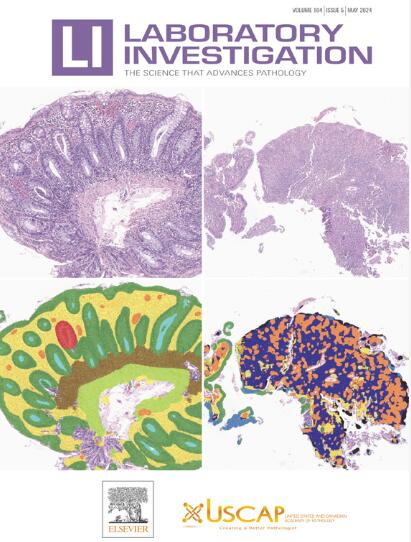基于肽组学和机器学习的乳腺癌 ncRNA 衍生微肽评估:表达模式和功能/治疗见解。
IF 5.1
2区 医学
Q1 MEDICINE, RESEARCH & EXPERIMENTAL
引用次数: 0
摘要
乳腺癌是一种高度异质性的疾病,其特点是由于分子改变而产生不同的亚型,从而使疾病具有不同的表型、临床表现和预后。ncRNA 衍生的微肽(MPs)一旦具有生物活性,就代表了癌症研究中的一层新的复杂性,具有作为生物标志物和治疗药物的潜力。然而,很少有大规模研究在肽组学水平上研究这些肽的表达,或评估它们在乳腺癌肽类治疗中的功能和潜力。在本研究中,我们提出了深化乳腺癌亚型中 ncRNA 衍生 MPs 的图谱,并推进对这些分子与疾病相关性的理解。首先,我们整合了之前发表的两份预测 ncRNA 衍生 MPs 列表,构建了 16,349 个独特的推测 MP 序列数据集。我们对不同亚型乳腺肿瘤样本的高通量质谱数据进行了表达评估。接下来,我们应用了几种机器学习和深度学习工具,如 AntiCP 2.0、MULocDeep、PEPstrMOD、Peptipedia 和 PreAIP,来预测其功能、细胞定位、三级结构、理化特征以及与治疗相关的其他特性。我们发现了 58 种在乳腺组织中表达的多肽,其中包括 27 种在肿瘤样本与非肿瘤样本中表达不同的多肽,以及表现出肿瘤或亚型特异性的多肽。这些多肽的理化特征与典型蛋白质组相一致,预计会影响肿瘤免疫环境,并参与细胞通讯、新陈代谢和信号转导过程。此外,一些 MPs 还具有抗癌、抗炎和抗血管生成分子的潜力。我们的数据表明,源自 ncRNA 的 MPs 具有与特定乳腺癌亚型和肿瘤特异性相关的表达模式,因此凸显了它们作为分子分类生物标志物的潜力。我们还进一步证实了 MPs 作为生物活性分子在乳腺肿瘤发生中的作用,以及它们在基于肽的疗法中的潜力。本文章由计算机程序翻译,如有差异,请以英文原文为准。
Peptidomics and Machine Learning–based Evaluation of Noncoding RNA–Derived Micropeptides in Breast Cancer: Expression Patterns and Functional/Therapeutic Insights
Breast cancer is a highly heterogeneous disease characterized by different subtypes arising from molecular alterations that give the disease different phenotypes, clinical behaviors, and prognostic. The noncoding RNA (ncRNA)–derived micropeptides (MPs) represent a novel layer of complexity in cancer study once they can be biologically active and can present potential as biomarkers and also in therapeutics. However, few large-scale studies address the expression of these peptides at the peptidomics level or evaluate their functions and potential in peptide-based therapeutics for breast cancer. In this study, we propose deepening the landscape of ncRNA-derived MPs in breast cancer subtypes and advance the comprehension of the relevance of these molecules to the disease. First, we constructed a 16,349 unique putative MP sequence data set by integrating 2 previously published lists of predicted ncRNA-derived MPs. We evaluated its expression on high-throughput mass spectrometry data of breast tumor samples from different subtypes. Next, we applied several machine and deep learning tools, such as AntiCP 2.0, MULocDeep, PEPstrMOD, Peptipedia, and PreAIP, to predict its functions, cellular localization, tertiary structure, physicochemical features, and other properties related to therapeutics. We identified 58 peptides expressed on breast tissue, including 27 differentially expressed MPs in tumor compared with nontumor samples and MPs exhibiting tumor or subtype specificity. These peptides presented physicochemical features compatible with the canonical proteome and were predicted to influence the tumor immune environment and participate in cell communication, metabolism, and signaling processes. In addition, some MPs presented potential as anticancer, antiinflammatory, and antiangiogenic molecules. Our data demonstrate that MPs derived from ncRNAs have expression patterns associated with specific breast cancer subtypes and tumor specificity, thus highlighting their potential as biomarkers for molecular classification. We also reinforce the relevance of MPs as biologically active molecules that play a role in breast tumorigenesis, besides their potential in peptide-based therapeutics.
求助全文
通过发布文献求助,成功后即可免费获取论文全文。
去求助
来源期刊

Laboratory Investigation
医学-病理学
CiteScore
8.30
自引率
0.00%
发文量
125
审稿时长
2 months
期刊介绍:
Laboratory Investigation is an international journal owned by the United States and Canadian Academy of Pathology. Laboratory Investigation offers prompt publication of high-quality original research in all biomedical disciplines relating to the understanding of human disease and the application of new methods to the diagnosis of disease. Both human and experimental studies are welcome.
 求助内容:
求助内容: 应助结果提醒方式:
应助结果提醒方式:


